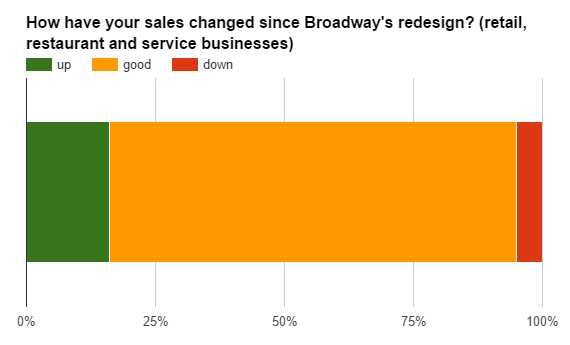
Michael Andersen blogs for The Green Lane Project, a PeopleForBikes program that helps U.S. cities build better bike lanes to create low-stress streets.
Protected bike lanes require space on the street, and removing curbside auto parking is one of several ways to find it. But whenever cities propose parking removal, retailers understandably worry.
A growing body of evidence suggests that if bike lanes and parking removal contribute to a street with calmer traffic and a better pedestrian environment, everybody can win.
In an in-house study of its new protected bike lane, Salt Lake City found that when parking removal was done as part of a wide-ranging investment in the streetscape -- including street planters, better crosswalks, public art, and colored pavement -- converting parking spaces to high-quality bike lanes coincided with a jump in retail sales.
On 300 South, a street that's also known as Broadway, SLC converted six blocks of diagonal parking to parallel parking and also shifted parallel parking away from the curb on three blocks to create nine blocks of protected bike lanes on its historic downtown business corridor.

It added up to a major road diet on part of the street (from five general travel lanes to three) and much less auto parking on another part (a 30 percent cut total).
So what happened?
Using sales tax data, the city compared retail sales along Broadway in the first half of 2013, before the changes, to the first half of 2015.
Along the project route, sales rose 8.8 percent, compared to 7 percent citywide.

It wasn't just a matter of dollars. The city's "business ombudsman" also did door-to-door surveys with managers of the street's 90 retail, restaurant and service storefronts, asking what they thought of the changes and recording them "being conservative so as not to overstate support."
Ninety percent of the businesses were reached. Here's what they said:


"Both customers and employees love the bike lanes," Jeff Telicson, manager of the Copper Onion restaurant, told the city. "We need more bike parking!"
On October 17, the city is planning to celebrate these great results, along with the official opening of one of the country's first protected intersections, at SLC's first Biketoberfest block party downtown.
How could the addition of bike lanes be related to higher sales? One way, of course, is that protected lanes increase bike traffic on the street. Customers arriving by bike not only tend to be more loyal, they also require much less parking space per wallet, so it's the best kind of traffic for a business.
Bike traffic jumped 30 percent after the bike lane's installation, the city found.
But that's probably not the main reason for the sales jump. Instead -- as on New York City streets, which found similar results in a 2013 study of sales tax data -- Salt Lake City's experience suggests that bike lanes can make street a more pleasant place to linger, which is good for retailers.
"I think the key thing is the feel of the street," said Phil Sarnoff, executive director of Bike Utah.
Sarnoff said that thanks to the parallel parking and reduction of motor vehicle lanes, car traffic had slowed down and more people in cars tend to stop for people at crosswalks.
"It's never felt like a Broadway," Sarnoff said. "Prior to this, it didn't feel like a street that people want to walk up and down. I think it's changed a little bit."

That's why even the owner of a plant store, John Mueller of Paradise Palm on Broadway, can see sales go up as a result of a project that makes biking easier.
"The bike lanes and lower speed limits help to calm car traffic and increase pedestrian traffic — all positives for my business," Mueller told the city. "Business is up 20 percent since last year."

Becka Roolf, SLC's bike and pedestrian coordinator, said that even people who drive to shop downtown spend much of their time walking from place to place. That's why the walking experience on Broadway seems to be more important to business there than the speed at which people can drive past or the ease of finding a parking spot.
"It makes it feel like you're not always being surrounded by moving traffic," Roolf said. "It just makes the street a better place to hang out. And most of time Americans when we hang out, we spend money."
You can follow The Green Lane Project on LinkedIn, Twitter and Facebook or sign up for its weekly news digest about protected bike lanes.






